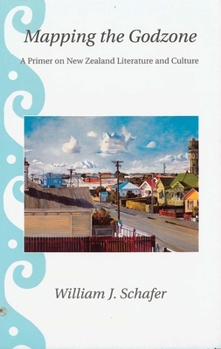Mapping the Godzone: A Primer on New Zealand Literature and Culture
William Schafer read, and dreamed, about New Zealand before his first visit in 1995. Mapping the Godzone grew out of that visit and his attempts, as an American, to focus his impressions of New Zealand's literary culture and relate its mental and moral landscape to that of the United States. Through an idiosyncratic selection of contemporary novels and films, Schafer opens up a complex and compelling world. Readers will encounter internationally celebrated writers such as Witi Ihimaera, Fiona Kidman, Ronald Hugh Morrieson, Maurice Shadbolt, Albert Wendt, Alan Duff, Keri Hulme, Patricia Grace, Ian Wedde, and Janet Frame; and the emerging New Zealand film industry and the handful of directors (among them Jane Campion, Peter Jackson, Vincent Ward, and Geoff Murphy) who have created a vital cinema renaissance since the 1970s. Stimulating and highly original in its approach, Mapping the Godzone is an eloquent reflection on a remote island nation.
Format:Paperback
Language:English
ISBN:0824820169
ISBN13:9780824820169
Release Date:July 1998
Publisher:University of Hawaii Press
Length:216 Pages
Weight:0.76 lbs.
Dimensions:0.7" x 5.5" x 8.5"
Customer Reviews
1 rating
Useful introduction
Published by Thriftbooks.com User , 21 years ago
The premise of this book is fantastic: it aims to be an introduction to New Zealand culture geared toward the educated but non-specialist American. By explaining dominant trends in NZ literature, describing some of this literature's historical context, and relating it to American culture, William Schafer outlines some answers to the questions of what it means to live in New Zealand, and how that nation has structured its unique identity. On a more basic level, this book gives its readers a sense of what NZ lit and film is available, and thus provides a spring board for an independent exploration of NZ culture. Schafer's quotes and discussion of the fiction of Witi Imihaera (author of the novel The Whale Rider, upon which the 2003 film is based), for instance, were particularly attractive to me and, as a result, I have since read several of his works. Mapping the Godzone opened a new world to me, and I look forward to continuing to explore NZ culture under its guidance.While the book's aims are laudable, its execution is not quite as impressive. Schafer tries to avoid the jargon and heavily theoretical analysis of contemporary literary criticism, but at times he slips up and his prose drags. At other times, he is somewhat too summary in his discussions--particularly when he relies on series of lengthy quotes by other critics. The quotes from literary sources should be well appreciated, since they provide a window into the style of many authors; the quotes from scholars simply seem to point to laziness on the part of the author. Could he not sum up the material himself? Besides these (not too grave) issues of style, the content of the book could have been improved. Clearly Schafer (an English professor) was mostly interested in the literary achievements of New Zealand. However, he does intend his book to be a primer on culture as well, and to achieve this end he would have done well to include more of popular and visual culture in his book. He does write a short section on film, but it consists mostly of a list of movies that the reader might find interesting.Despite its flaws and shortcomings, Mapping the Godzone is a unique resource for the American reader curious about New Zealand, and it seems to be an excellent overview of that country's literature. I am glad to have found it.






